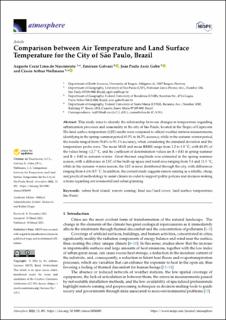| dc.contributor.author | Lima Do Nascimento, Augusto Cezar | |
| dc.contributor.author | Galvani, Emerson | |
| dc.contributor.author | Gobo, João Paulo Assis | |
| dc.contributor.author | Wollmann, Cássio Arthur | |
| dc.date.accessioned | 2022-06-30T12:48:32Z | |
| dc.date.available | 2022-06-30T12:48:32Z | |
| dc.date.created | 2022-06-10T08:59:33Z | |
| dc.date.issued | 2022 | |
| dc.identifier.issn | 2073-4433 | |
| dc.identifier.uri | https://hdl.handle.net/11250/3001797 | |
| dc.description.abstract | This study aims to identify the relationship between changes in temperature regarding urbanization processes and seasonality in the city of São Paulo, located in the Tropic of Capricorn. The land surface temperature (LST) results were compared to official weather stations measurements, identifying in the spring–summer period 65.5% to 86.2% accuracy, while in the autumn–winter period, the results ranged from 58.6% to 93.1% accuracy, when considering the standard deviation and the temperature probe error. The mean MAE and mean RMSE range from 1.2 to 1.9 °C, with 83.0% of the values being ≤2.7 °C, and the coefficient of determination values are R = 0.81 in spring–summer and R = 0.82 in autumn–winter. Great thermal amplitude was estimated in the spring–summer season, with a difference in LST of the built-up space and rural area ranging from 5.8 and 11.5 °C, while in the autumn–winter season, the LST is more distributed through the city, with differences ranging from 4.4 to 8.5 °C. In addition, the current study suggests remote sensing as a reliable, cheap, and practical methodology to assist climate in order to support public policies and decision-making actions regarding environmental and urban planning. | en_US |
| dc.language.iso | eng | en_US |
| dc.publisher | MDPI | en_US |
| dc.rights | Navngivelse 4.0 Internasjonal | * |
| dc.rights.uri | http://creativecommons.org/licenses/by/4.0/deed.no | * |
| dc.title | Comparison between Air Temperature and Land Surface Temperature for the City of São Paulo, Brazil | en_US |
| dc.type | Journal article | en_US |
| dc.type | Peer reviewed | en_US |
| dc.description.version | publishedVersion | en_US |
| dc.rights.holder | Copyright 2022 by the authors | en_US |
| dc.source.articlenumber | 491 | en_US |
| cristin.ispublished | true | |
| cristin.fulltext | original | |
| cristin.qualitycode | 1 | |
| dc.identifier.doi | 10.3390/atmos13030491 | |
| dc.identifier.cristin | 2030667 | |
| dc.source.journal | Atmosphere | en_US |
| dc.identifier.citation | Atmosphere. 2022, 13 (3), 491. | en_US |
| dc.source.volume | 13 | en_US |
| dc.source.issue | 3 | en_US |

